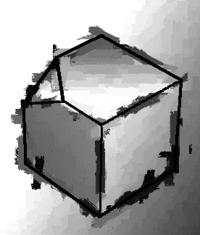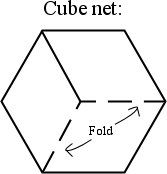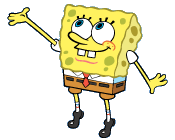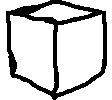Cube
- This article is about the shape. For other uses, see Cube (disambiguation).
“A man may mime an invisible cube, and the drinking, but not the passion.”
The cube, also known as the frinkohedron is an idealized geometrical figure known to have 3 faces, 9 edges, and 7 corners. Though wags have postulated more faces, edges, and corners, seeing all of the real and conjectured faces at once has proven futile. The characterization of the cube is a more recent development in geometrical theory, actually the last of the great problems of geometry to be fully solved.
Origin[edit | edit source]

The concept of a cube was first conceived by the ancient smurfs, and is recorded in their primitive writings as "Kube" (sic; this was before the invention of spelling). The figure was imagined yet not visualized, and mathematicians for thousands of years could only speculate as to its shape. Gauss's guess was that its shape resembled a short rolling pin, flattened in places. The first correct visualization of the cube was made by the first female mathematician, Renée Descartes, who applied her Descartesian coordinate system with the parameters (0, 0, 0, 9am) and (1, 1, 1, noon), where the first three are spacial coordinates and the last is the Time Cube index for the implicit earth rotation. This produced a foundation that, with some rough sketching using a broken charcoal pencil, created the ideal cube we know today.
Proofs of impracticality[edit | edit source]
Today, all of the true, perfect cubes of foundation have been snapped up by major technology companies. It is impossible for the average individual to own a perfect cube for these reasons:
- Each face of a cube is actually made up of an infinite number of lines, stacked atop one another. Even if one had all those lines, the cloning technology is not available to create all three faces.
- The volume of a cube is made up of an infinite number of pentagons. Same reason as previous.
- The reader must visualize an ant on a paper plane surface. It can move in two dimensions, but not upward or downward. The best estimate of a third dimension it can tell its buddies at the co-op is an infinite number of two-dimensional pentagons, leading to the same reasoning as the above two.
- A cube is a type of rectangular prism; it diffracts light. Imagining you could get ahold of a prism, it would never be a cube as the diffraction patterns could not be perfectly aligned.
- If an ant could think, it would defy reality. Since ants are part of reality, and the imagining of the many pentagons requires thought, the existence of many pentagons would defy reality.
“You are so drunk.”
- OK, peanut gallery, how about this. Material things are not ideal. Material things must die, but ideals are forever. Therefore, since Cube has not died, it is not material and therefore cannot be constructed... yet. But even if it is material everyone will probably die before Cube because it's cool.
“OK, dude, now you're stoned.”
- Right, you asked for it. We will construct a 1-unit-long line segment at the origin, representing the base edge of the cube. Now we shoot an infinite number of points at the line on . The probability of any one point hitting the line segment is:
- So it doesn't matter how many points you shoot at the line; they all have P = 0 of hitting. Therefore the line doesn't exist. Therefore the cube doesn't exist. Happy now?
“Whoa.”
Philosophy[edit | edit source]
Cubes are known for the property of emitting their faces and edges twice: once to the naked eye, and once to mirrors, shiny objects, cameras, your other eye, another observer, or other means of detection. Crackpots point to this behaviour when claiming that a cube actually has 6 sides, 8 corners, and 12 edges, which are now known to be false, pseudoscientific derivations from the human spirit combined with vague assertions about properties of space and nature. Philosophers like Nietzsche, Plato, and Cato have expounded at length on this phenomenon, (termed polyphotosity) and its implications for the relationship between the human mind and the universe. Popular wisdom is generally predisposed against pursuing such heretical ideas any further, fearing some form of dystopia.
Visibility[edit | edit source]
At one moment, zero to six sides may be visible to an observer, depending on the position of the 1x1x1 Rubik's cube relative to the position of the observer's view frustum, the observer's visual sensing capabilities, such as snarpness and focus, and the use of tools characteristic of the animal species homo sapiens.
Transparent 1x1x1 Rubik's cube[edit | edit source]
Provided that the cube is fully within the observer's view frustum, all of the cube's sides (6) are visible. Otherwise, zero to five of the cube's sides are visible - zero sides being visible when the cube is completely outside the view frustum.
Opaque 1x1x1 Rubik's cube[edit | edit source]
0 sides of the cube are visible when the cube does not intersect with the observer's view frustum. Otherwise, up to three sides of the cube are visible.
Advanced observing mechanisms, that are composed of more than one view points, such as the ones of the homo sapiens series, may observe more than three sides of the cube at once. Observing the cube through two or more view points at the same time, based on the relative positions of the view points and the size of the cube, up to six sides may be visible.
N-dimensional beigns (n >= 4) may observe all the sides of the cube at once naturally.
Do it yourself (animals with at least two eyes only): Take a 1x1x1 cube and place it very near your eyes, directly facing and focusing on one side of the cube. You should be able to see 3 sides of the cube. Rotate the cube to change the number of visible sides. (Hint: best results achieved when the cube is 45 degrees rotated around the y-axis).
Observing tools[edit | edit source]
So far, the best tool invented for cube observation is 'The 1x1x1 Rubik's cube observation tool', also known as T111RCOT. T111RCO consists of one mirror, though versions that use more than one mirror are being developed.
T111RCO is used while observing the cube using the view method described in the do it yourself section. Placing the mirror close enough to the points of view, while keeping the cube in between, the observer may observe 5 sides of the cube directly and one side as a reflection in the T111RCO. The device may not function correctly if the back side of the cube were covered with a small miror.
Applications[edit | edit source]
Though once solely a pastime of the elite, the cube has found small uses in a number of different areas:
Arts[edit | edit source]
A genre of art, cubism, cropped up in the mid 1960's entirely devoted to the cube, its aloof loneliness and rectangular aesthetic. The original or "classical" works sprang from Descartes's charcoal drawing, duplicated, colourised, repeated, and otherwise manipulated to give a pop-art effect. Later paintings were more refined, but all were centred around the theme of human courage, creativity, and energy, all stuffed into a demure, rectangular metal cage and left to rot.
Crime and war[edit | edit source]
A well-known property of all cubes is their ability to divide space into equal parts, ripping apart molecular structures in the process. Good replicas of the cube cut through solid objects and people like butter. This naturally led the military, as well as all manner of ne'er-do-wells, to take notice. The apex of this potential was realised in the Cube Scare of 1940, which saw Adolph Hitler dropping high-grade cubes on London homes, tearing square holes through chimneys and mailboxes.
The damage was so extensive that the government, then headed by Neville Chamberlain, took the initiative, and completely defused the cube threat using spheres, which have inverse properties. The spheres are best recognised as street lights, which serve no real purpose during the day except to prevent new attacks. Ever since the crisis, British law has required that all objects have rounded corners so that children do not injure themselves.
Economy[edit | edit source]
Cube replicas are also extremely absorbent, sucking up whatever shapes they touch. The scientific reason for this is that cubes' shape is so boring, other shapes and textures rush into it through osmosis. This is extremely productive in design: for example, a cube pressed against a famous painting will become a stamp in effect. Several product recalls in the latter half of the 20th century were a direct result of essential machine components being cubist phonies.
More controversially, employee workspaces have been fashioned in the shape of the Cube. Euphemistically dubbed "cubicles," these cube-shaped traps suck away workers' life force and skills during their workdays. It is hence a challenge for senior employees, retired from one job, to find another later in life. Several advocacy groups exist, all arguing with vehemence legislation should be introduced to substitute simple dividers or cylinders in private offices. The Dilbert comic strip also parodies the skill absorbency effect frequently.
Architecture[edit | edit source]
Ancient civil architect Frank Lloyd Wright understood the power and strength of cubes stacked atop one another. Until his time, the only use for cubes in structures was as garbage cans, dustbins of history. Wright reshaped people's view along with their structures, showing people that the cube and allied shapes were not only more dynamic than others, they were also sexier. Within a decade, life in cubic apartments was more euphoric than mood rings. Today, the reason cubes are favoured in modern highrises is that they present maximum advertising space on each face.
Mathematics[edit | edit source]
Because a cube has three faces, there is enough room inside to contain a lot more numbers than another of the same area. (How much more depends on the receptacle the numbers were stored and shipped in.) It is for this reason that in mathematics we often write:
Cube The Movie[edit | edit source]
In 1997 a movie was made in Canada starring Ice Cube, Gene Ray and David Hewlett about a large cube that roams the streets of New Jersey killing people. After ten years it has gained a cult status and is generally regarded as one of the Top Ten Films of All Time and Space. Leading scientists have unanimously determined upon multiple viewings of this film that people getting diced by wire screens is Awesome.
The cube is also the second strongest shape, yet has more room than a triangle, that is why it is used as boxes.
Inferiority to the Rectangle[edit | edit source]
The cube, as tolerable and openly African American as it may be, is and will always be inferior to the rectangle, the most perfect of all shapes. The cube is kind of like the annoying little brother of the proper Rectangle. It doesn't matter that the cube is a type of rectangular prism; it's just not the same. Besides, the first shapes in the world were rectangles. I can prove it, too; just ask any old rectangle walking down the street, and they’ll tell it to you straight. Bitch.
The Earth's Secret Life as a Cube[edit | edit source]
Despite popular belief among the tribes of New Guinea, the Earth is in fact a cube. This is because, unlike all the other, proper, rectangular planets, the Earth is the least perfect of all the planets, aside from Neptune of course. Neptune is a stupid fucking Dodecahedron. And not the good kind either. The shitty kind.

![{\displaystyle [0,\infty ]}](https://wikimedia.org/api/rest_v1/media/math/render/svg/52088d5605716e18068a460dec118214954a68e9)








